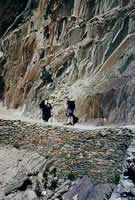Timeless Footsteps
-John Eickert
There are extraordinary trekking opportunities. There are many places to trek throughout the world, but some are special. For me, special elements create a special trek. Wildlife, solitude, scenery, culture, and difficulty
are some of those elements. The trek over Wari La, an ancient route linking the Indus valley in Ladakh with the Shyok/Nubra valleys, adds another element to the list, a chance to follow timeless footsteps. Since man found he was not alone he has traded with
his neighbors. The grains grown in Ladakh have been transported over high passes to Panamik. Lasirmou La, Khardung La, Digar La, and Wari La are some of these passes. The traders making the return trip brought dates and apricots up to Ladakh. Now, Khardung
has a road and the others are seldom used, perfect for trekking.
My plan was to ride to Panamik and walk back to Leh via Wari La and Tak Tok. I hoped Khardung would provide acclimatization and this agenda would conceal my intention. At that time, permits were not being issued for trekking
over Wari La. In Panamik, I walked the sand dunes and rode a camel. I met a man who was willing to use his pack pony for our trek. My partner and guide then intended to sell his pony in Leh and return via Khardung. We planned for a seven-day outing.
On the first day, we walked to Khalsar. The next day was some uphill to Agham. From Agham it took three days to cross Wari. The day over the pass was long and the trail was very steep. The north
side of the pass held much snow though it was high summer. On the south side, we stopped at a herder’s shelter and were glad for the day to end. I had hoped I might see some of the peaks of the Karakoram, but they were too far. As we sat that night watching
the sky and eating a dinner of rice and apricots I considered how many footsteps had crossed that pass in the previous millennia. They crossed not seeking adventure, but trade. The next day we walked to Tak Tok. The day after I caught a ride into Leh and said
farewell to my partner and his pony. As we waved, good-bye, I considered the previous six days and the time spent trekking with someone who spoke a mixture of Tibetan and Ladakhi, but no English. Somehow, we got on just fine.
To walk from sand dunes to glaciers along an ancient route is an opportunity to follow many footsteps and walk in time. We saw marmots, blue sheep, a lone Siberian Ibex, and a pair of golden eagles. We saw no one
when crossing Wari La and there were no human footprints in the summit snow. It was hot in Panamik and freezing in Tak Tok. I spent one last day in Leh and then flew to Delhi. When will you go? Cheers. 